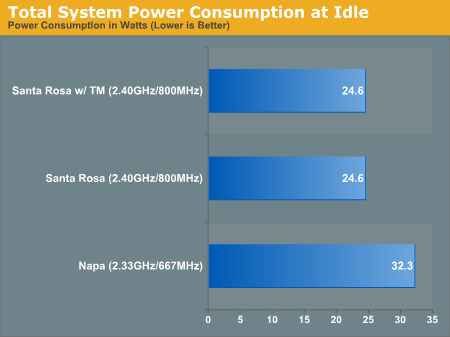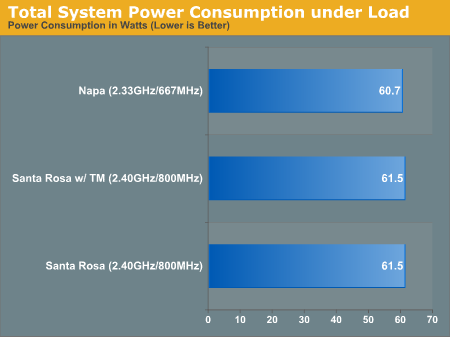Intel Santa Rosa Preview: Centrino V Evolves
by Anand Lal Shimpi on May 10, 2007 12:00 AM EST- Posted in
- Laptops
Power Consumption:
As we mentioned on our test page, we couldn't do an apples to apples comparison of battery life between the old Centrino and the new Santa Rosa platform due to having two very different notebooks. That being said, we did want to look at power consumption to get a vague idea of how these systems compared in power draw.
We looked at power consumption at idle and under 100% load while running our WME9 test:

At idle, our new Santa Rosa platform actually uses less power than its predecessor. We wouldn't put too much weight in this number because it could be due to a number of factors unrelated to the new platform, although the ability to run at a lower FSB at idle could most definitely play a large part.

Under load, we have Santa Rosa consuming a bit more power than its predecessor, which is honestly what we'd expect. With a faster FSB and no real improvements to power management when the CPU is under load, Santa Rosa will eat up the minutes left on your battery quicker than its predecessor when you're actually getting work done. At idle, we'd honestly expect it to be a toss up between Santa Rosa and its predecessor, with the new platform possibly even coming in a bit lower on the power meter thanks to the enhancements made to the platform. Remembering that the two power management features Intel added to Santa Rosa (adjustable FSB frequency and chipset-CPU handshaking improvements) only work during idle periods, this generalization about battery life makes sense.
Adding Turbo Memory into the mix could change things as it is supposed to increase battery life, but we simply don't know at this point. We didn't see any change in power consumption with Intel's Turbo Memory enabled or disabled, but that could be the fault of our test platform.
As we mentioned on our test page, we couldn't do an apples to apples comparison of battery life between the old Centrino and the new Santa Rosa platform due to having two very different notebooks. That being said, we did want to look at power consumption to get a vague idea of how these systems compared in power draw.
We looked at power consumption at idle and under 100% load while running our WME9 test:

At idle, our new Santa Rosa platform actually uses less power than its predecessor. We wouldn't put too much weight in this number because it could be due to a number of factors unrelated to the new platform, although the ability to run at a lower FSB at idle could most definitely play a large part.

Under load, we have Santa Rosa consuming a bit more power than its predecessor, which is honestly what we'd expect. With a faster FSB and no real improvements to power management when the CPU is under load, Santa Rosa will eat up the minutes left on your battery quicker than its predecessor when you're actually getting work done. At idle, we'd honestly expect it to be a toss up between Santa Rosa and its predecessor, with the new platform possibly even coming in a bit lower on the power meter thanks to the enhancements made to the platform. Remembering that the two power management features Intel added to Santa Rosa (adjustable FSB frequency and chipset-CPU handshaking improvements) only work during idle periods, this generalization about battery life makes sense.
Adding Turbo Memory into the mix could change things as it is supposed to increase battery life, but we simply don't know at this point. We didn't see any change in power consumption with Intel's Turbo Memory enabled or disabled, but that could be the fault of our test platform.










22 Comments
View All Comments
Cat - Thursday, May 10, 2007 - link
I thought Santa Rosa was going to have a low-power display mode that effectively used interlacing. Did I just imagine this?IntelUser2000 - Thursday, May 10, 2007 - link
Yea, LCD's twist pixel(something like that) to refresh screen, but on apps that doesn't require high refresh(like word for example) it'll lower the twisting rate.
Though I don't know if its in the system AT reviewed. I think this is probably the worst review Anand himself ever did.
mongoosesRawesome - Thursday, May 10, 2007 - link
I've read that the Santa Rosa CPU's can shut down one core in single threaded applications and overclock the other core in order to increase performance, all while maintaining the same thermal envelope.How much overclocking are we talking about? Is the performance increase tangible? Can you test this?
Does one core shut down in idle mode anyways?
IntelUser2000 - Thursday, May 10, 2007 - link
It clocks one speed bin higher(eg. 2.4 to 2.6GHz) when one core is idle(single threaded apps) and is available on non-extreme Core 2 Duo mobile processors.
coolme - Wednesday, May 16, 2007 - link
Can you provide more specifics? What exactly does it do? Increase bus speed? or increase multiplier? When exactly does the process kick in? Possible benchmarks?retrospooty - Wednesday, May 9, 2007 - link
that with all the hype about the flash memory dramatically improving speed, that Intel would allow pre-release benchmarking to be done without at least a solid explanation as to why it isn't any faster. I wonder whats up with that.Freddo - Wednesday, May 9, 2007 - link
In the CPU table on the 2nd page, what exactly is the Median Average Power value? How many watt the CPU use while it's on idle doing "nothing" and the OS is on?1W is very little, which is nice, and would give long battery times if one keep doing things that doesn't require much CPU power, like simple stuff in Word, Excel and so on.
If that's the case, the difference between the T and L series is much smaller than I expected too, considering the L CPUs have a noticeably lower TDP.
Or am I totally off the hook here?
IntelUser2000 - Wednesday, May 9, 2007 - link
Yea, you got the general idea of it. Intel isn't specific about it either. It's pretty ambigous claim. It's usually quoted as: "Average power consumption while doing typical tasks" or "Average power consumption while running mobilemark to simulate typical tasks". I'd guess it is office stuff like Word.
The Core 2 Duo chips on the Santa Rosa platform has enhanced deeper sleep power of 1.2W and the LV editions are 0.8W. I'd guess that's pretty close to what they are claiming. The more important power consumption figures are the ones in HFM/LFM mode. Santa Rosa platform adds Super LFM, and reduces TDP at that level significantly. This POS adobe reader won't load so I can't quote the figures, but the numbers are quite lower than the one based on Napa.
Freddo - Thursday, May 10, 2007 - link
Thanks for the info :)fehu - Wednesday, May 9, 2007 - link
Maybe this tecnology start working when vista know what are the most common used file and preload them on the robson module